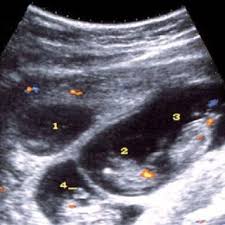Scanning a multiple gestation pregnancy would be much more difficult than scanning a singleton already is. There is much to look for, and so much more to document. Whatever vast list of things you would need to measure and image on one baby, the list grows in multiple depending on how many twins are involved.
How I would approach this is starting off as usual, scanning mother and making sure all is well with cervix, ovaries, adnexa, etc. Next, I would move on by sweeping in both planes to really quantify the number of fetuses, yolk sac, etc seen. Once sure, I would label alphabetically starting by the fetus closest to cervix to keep future scans orderly and cohesive.
After counting and labelling, I would then start checking for chorionicity and amnionicity, looking for the Twin Peak sign or the T sign. This is very important because monochorion and especially monoamnion is subject to much higher rates of complications. For example, something to really pay attention to is the shared placenta, as TTTS could cause fetal demise. Another thing to look for, while noting if twins are sharing everything, is whether or not they are conjoined. If not, is one CRL or gestational age measured at a way different date than another? These are all extra things to look out for when it comes to multiple gestations.
Here is an image of fetal papyraceus, a fetal demise that happens with TTTS. The fetus that does not survive ends up compressed and "paper-like." Sonographic images are much easier to digest than the real life pictures that google can pull up. Next to it is a happy image of quadruplets, where one pair is monochorionic!
 .
. 
Article on Fetus Papyraceus or Vanishing Twin: https://sonoworld.com/fetus/page.aspx?id=296


